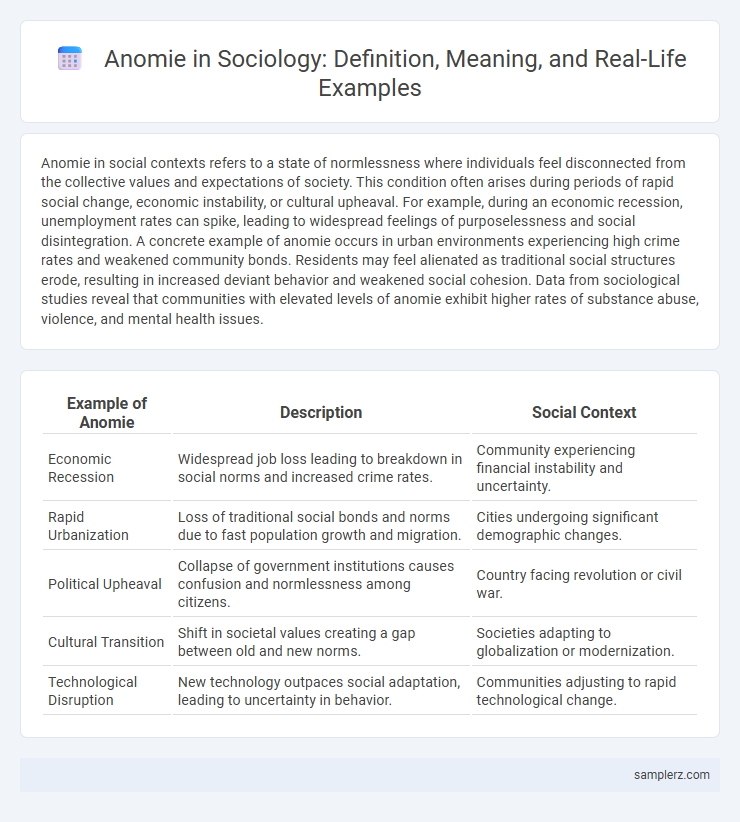Anomie in social contexts refers to a state of normlessness where individuals feel disconnected from the collective values and expectations of society. This condition often arises during periods of rapid social change, economic instability, or cultural upheaval. For example, during an economic recession, unemployment rates can spike, leading to widespread feelings of purposelessness and social disintegration. A concrete example of anomie occurs in urban environments experiencing high crime rates and weakened community bonds. Residents may feel alienated as traditional social structures erode, resulting in increased deviant behavior and weakened social cohesion. Data from sociological studies reveal that communities with elevated levels of anomie exhibit higher rates of substance abuse, violence, and mental health issues.
Table of Comparison
| Example of Anomie | Description | Social Context |
|---|---|---|
| Economic Recession | Widespread job loss leading to breakdown in social norms and increased crime rates. | Community experiencing financial instability and uncertainty. |
| Rapid Urbanization | Loss of traditional social bonds and norms due to fast population growth and migration. | Cities undergoing significant demographic changes. |
| Political Upheaval | Collapse of government institutions causes confusion and normlessness among citizens. | Country facing revolution or civil war. |
| Cultural Transition | Shift in societal values creating a gap between old and new norms. | Societies adapting to globalization or modernization. |
| Technological Disruption | New technology outpaces social adaptation, leading to uncertainty in behavior. | Communities adjusting to rapid technological change. |
Understanding Anomie in Contemporary Society
Anomie in contemporary society arises when rapid social changes disrupt collective norms, leading to feelings of alienation and normlessness among individuals. Urbanization and technological advancements often weaken traditional community bonds, causing social instability and increased deviant behavior. Research shows that rising rates of unemployment and social inequality exacerbate the sense of anomie, highlighting its impact on mental health and social cohesion.
Social Media and the Rise of Anomie
The rise of social media has accelerated feelings of anomie by fostering superficial connections and diminishing genuine social bonds, which contribute to a sense of isolation and meaninglessness among users. Algorithms prioritize engagement over authentic interaction, amplifying echo chambers and social fragmentation. This digital environment weakens traditional community norms, resulting in increased social alienation and decreased collective cohesion.
Urbanization: A Breeding Ground for Social Anomie
Rapid urbanization often leads to social anomie by disrupting traditional community bonds and creating a sense of isolation among city dwellers. High-density living, diverse populations, and constant social mobility contribute to weakened shared norms and values, fostering feelings of normlessness and alienation. This breakdown in social cohesion can increase crime rates, mental health issues, and overall social instability within urban environments.
Anomie in Educational Institutions
Anomie in educational institutions manifests as students experiencing a breakdown of social norms and a lack of clear guidance, leading to feelings of isolation and disengagement. This phenomenon results in increased dropout rates, diminished academic performance, and behavioral issues such as bullying and absenteeism. Research highlights that schools with weak community ties and inconsistent disciplinary policies exacerbate anomie, undermining students' sense of belonging and social cohesion.
The Impact of Economic Instability on Social Anomie
Economic instability exacerbates social anomie by disrupting established social norms and weakening community cohesion. Rising unemployment and financial insecurity contribute to feelings of isolation and normlessness among individuals. This breakdown in social regulation increases the likelihood of deviant behavior and undermines collective trust within society.
Youth Disconnection: A Modern Example of Anomie
Youth disconnection exemplifies anomie through the growing sense of social alienation and normlessness experienced by young people detached from education, employment, or community engagement. This disconnection leads to increased risks of mental health issues, delinquency, and a breakdown in social cohesion as traditional social structures fail to integrate and support them. Rising rates of youth unemployment and disengagement highlight the critical need for targeted social policies to restore a sense of belonging and shared purpose.
Anomie and the Breakdown of Family Structures
Anomie manifests in social contexts through the breakdown of family structures, where weakened social norms lead to increased familial conflicts and instability. This erosion of traditional family roles contributes to higher rates of divorce, single-parent households, and diminished parental supervision, exacerbating social disintegration. Studies demonstrate that communities with prevalent family disintegration tend to experience elevated crime rates and reduced social cohesion.
Cultural Shifts and Growing Feelings of Anomie
Rapid cultural shifts, such as the rise of digital technology and changing social norms, contribute to growing feelings of anomie by disrupting traditional values and community bonds. Individuals experience social isolation and normlessness when the collective conscience weakens, leading to alienation and decreased social cohesion. This phenomenon often manifests in increased mental health issues and lower trust in societal institutions.
Political Disengagement as a Sign of Anomie
Political disengagement exemplifies anomie by reflecting a breakdown in social norms and citizen trust within a society. Voter apathy, declining party membership, and reduced public participation signal a detachment from collective political processes and eroded civic responsibility. These phenomena indicate weakened social cohesion and the diminishing influence of shared values in maintaining societal order.
Tackling Anomie: Community Initiatives and Solutions
Community initiatives such as neighborhood watch programs and local support groups effectively address social anomie by fostering trust and shared responsibility among residents. Collaborative efforts like urban gardening projects and cultural festivals reconnect individuals, enhancing social cohesion and reducing feelings of isolation. Implementing these solutions strengthens communal bonds, countering the disengagement central to anomic conditions.

example of anomie in social Infographic
 samplerz.com
samplerz.com